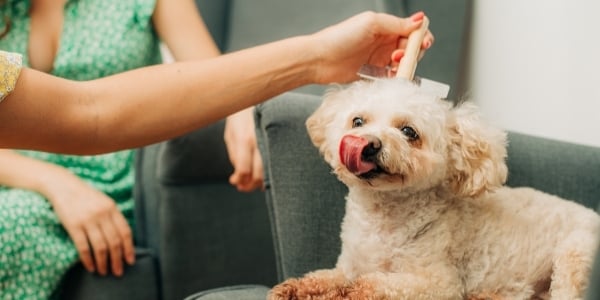 Mat alert! Dog fur often becomes tangled and knotted around itself without frequent brushing, which is called matting.
Mat alert! Dog fur often becomes tangled and knotted around itself without frequent brushing, which is called matting.
Mats occur frequently in many dog breeds with curly, fine, or double coats.
In extreme cases, the dog's coat will become what groomers call "pelted" — when matting is very tight to the skin, preventing proper airflow.
Matting and pelting prevent proper temperature regulation, cause skin irritation, hide parasites like fleas or other nasties, and cause extreme discomfort and pain for the dog.
Mats are mostly preventable! Let's look at why your dog's coat is forming mats and things you can do to keep them at bay. We'll also talk about what your options are if your dog's coat is already matted.
Why Does Your Dog's Fur Get Matted?
Mats form when dog fur becomes tangled and wraps around itself, forming tightly wound clumps of the loose dead fur and live fur. If not brushed out, they continue to trap more fur, becoming closer and closer to the dog's skin. Mats tend to frequently form in areas where there is lots of friction — think around the neck area where the collar sits, behind the ears (where we lovingly scratch them), under their chin, their armpits, under where their harness usually sits, their feet, and on the back of their rear legs.
Matting can occur more frequently during seasonal shedding periods when a dog is "blowing coat" to switch from their winter to summer coat or vice versa. If the loose fur isn't brushed out, it becomes impacted against the skin and forms mats and pelting if left too long. Dogs who like to swim are more prone to getting mats, because the moisture causes their hair to curl, and it dries wrapped around itself. Many dogs who are bathed but not thoroughly brushed and dried also develop matting.
While any dog with a longer or double coat can have matting, some dog breeds are more likely to mat than others — just ask any doodle owner. Doodle coats are a blend of a curly coat and a double-coat, making them the perfect storm for matting. Curly coated breeds like Poodles and Bichon Frisés also tend to easily mat without continued maintenance. The same goes for breeds with a long coat, Bearded Collies or Rough Coat Collies for example.
Mats vs. Cords
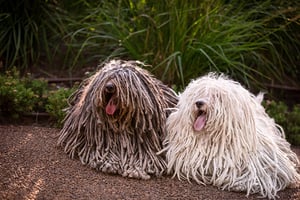
There are a few dog breeds whose coats are meant to be "corded" — where their coat is meticulously groomed by hand to form dreadlocks or cords. This might look like matting, but it's meant to be maintained and trimmed to prevent skin issues.
The most common breeds seen with a corded coat are the Puli, Komondor, and Bergamasco Shepherd. Many lovingly refer to these breeds as "mop dogs." Keeping their coat this way helps disguise them while they are working guarding and herding livestock.
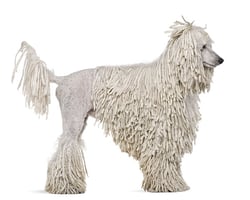
You might even see a Poodle or Havanese with a corded coat for aesthetic and showing purposes. Cording is not for a typical dog owner, as it requires extensive maintenance and an experienced hand at forming the cords and preventing matting underneath.
How to Prevent Matting in Your Dog's Fur
Regularly Brush Your Dog's Coat
The number one thing you can do to prevent matting in your dog's coat is regular and thorough combing and brushing. How often you should brush your dog depends on their coat type and if it's shedding "season" (when their coats change from a thinner summer coat to a thicker winter coat or vice versa). Breeds that have long coats, curly coats, or fine fur should be brushed more often, even daily in some cases, while other coat types might only need once a week.
One of the most common mistakes made when brushing a dog's fur is only combing the top layer, which actually can make matting worse. If you only focus on the top layer of your dog's fur, your brushing is actually pushing any loose fur and tangles down closer to the skin. You can avoid this by using the correct brush for your dog's coat type — such as an undercoat rake if your dog has a double coat, or a rotating pin comb or slicker brush if your dog has a single layer curly coat. Check out this article for an in-depth look at what combs or brushes work best for your dog's particular coat.
Using a detangling leave-in conditioning spray can make brushing easier as well, especially if your dog has a long coat that tangles easily. Spray the leave-in conditioner on your dog's damp coat after their bath and before drying, or lightly spray over dry fur and brush it through your dog's coat.
Remove Your Dog's Harness When Not In Use and Use a Rolled Leather Collar
Mats often form underneath your dog's collar or the parts of their chest and armpits where their walking harness rests. Remove their harness when they aren't on leash. Consider using a rolled leather collar instead of a flat collar to prevent tangles around their neck.
Make Regular Appointments With Your Professional Groomer
Some breeds and breed mixes require intensive coat maintenance to prevent matting, such as Poodles, Doodle-mixes, Coton de Tulear, and Bichon Frisés. Even with regular at-home brushing, their fine fur becomes matted very quickly, especially after it gets wet.
Even using an ear cleaning solution on a regular basis can be enough moisture to mat the hair around their ears (like in the photo below). Consider booking a professional brush-out service with your groomer between full grooming appointments to keep matting at bay, or request a partial grooming appointment (such as a Feet, Face, and Fanny service, or Beach Clip service).
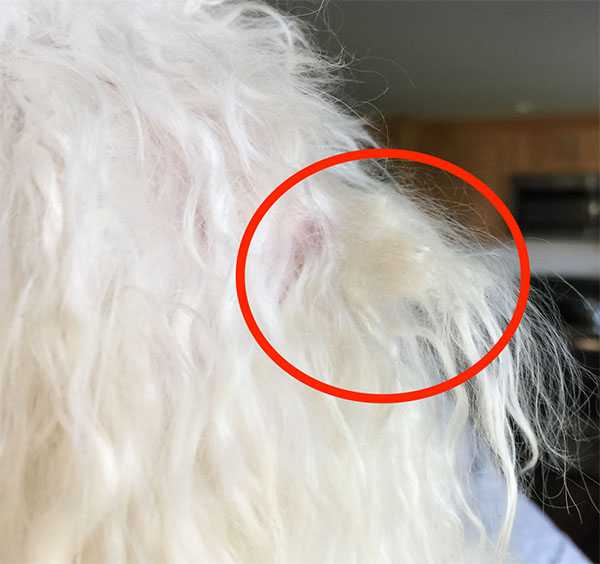
If you want to keep your dog's coat long, these maintenance appointments are essential, paired with daily brushing to prevent matting. We recommend going to the groomer for a full groom and haircut service every 6 to 8 weeks if you have a dog with a high maintenance coat type to keep their coat in tip-top shape.
Regular at-home brushing and maintenance appointments mean that your dog will have a much better time during their "spaw" treatments at the groomer. Even when done by a professional, mat removal can be very uncomfortable for the dog, and you don't want your dog associating that the groomer means a painful brush out or full shave every visit.
Pro Tip: Take your dog in to your groomer for fun mini-visits between appointments, where they get to say hi to staff and snack on some yummy treats. This will help build a positive association for your dog and prevent them from anticipating a bath and groom every time they go in.
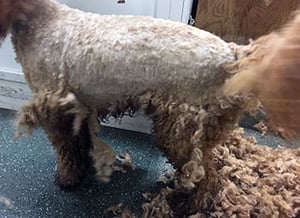 Keep Your Dog's Fur Trimmed Short
Keep Your Dog's Fur Trimmed Short
Another option to prevent matting is to keep your dog's coat trimmed nice and short, which also makes brushing easier. If you go this route, you will need to take them to the groomer more often.
A shorter haircut is only recommended for dogs with single-layer coats — double-coated breeds or breed mixes (Siberian Huskies, Labrador Retrievers, Golden Retrievers, Rottweilers, Corgis, etc.) should NOT be shaved unless recommended by your veterinarian for medical reasons.
Many dog owners think their double-coated breed will be cooler in the heat if they shave their coat, but shaving their outer coat down actually has the opposite effect! Shaving a dog's coat exposes their skin and puts them at increased risk of sunburn and skin cancer. Their outer coat is important for both temperature regulation and sun protection. Instead of shaving, a good brushing to get rid of any loose undercoat fur is the best way to help your double-coated dog stay cool.
Pro Tip: Do NOT shave a dog with a double-coat unless you have been directed to do so by your veterinarian.
Your Dog's Coat is Matted — What Now?
If you've found a mat or area of matting while brushing your dog, there are a few things you can do depending on the severity of the mat.
Brushing or Cutting Out Mats — Do or Don't?
You can try to pick at the mat with a comb or slicker brush, but this can be very painful for your dog. If you've ever had someone try to brush out a knot of hair on your head, you know what I'm talking about!
Unless the mat is very small and loose, brushing isn't your best option. Not only can it be very uncomfortable and painful for your pup, but it can create a negative brushing experience that will sour any future attempts at brushing.
- If brushing out a mat, spray on a small amount of detangling conditioner spray and try to loosen it a bit with your fingers.
- Once you've isolated the mat by hand from the surrounding fur, grab a slicker brush or grooming comb.
- Hold the base of the mat firmly with one hand to prevent the brushing from pulling painfully on your dog's skin.
- Start working on the mat at the furthest point from the skin rather than trying to brush from your dog's skin outwards.
- Use very small strokes with the brush, take frequent breaks, and give your dog some yummy treats!
Pro Tip: For brushing sessions with your pup, use a Licking Mat smeared with peanut butter or wet dog food that they can work on while being brushed out. Not only will this help with the extra wiggly dogs, but it also helps build a positive association with brushing time.
If you're thinking about cutting out the mat with scissors at home — put the scissors down! Do not use scissors to cut out mats unless you are properly trained, have the proper grooming scissors, feel comfortable doing so, and have a good blood-clotting powder handy.
Using scissors instead of clippers to trim out any matting often results in injury to your dog. You never want to pull the mat up from the skin and then cut underneath, as their extended skin can get snipped off as well. If that happens you’ll need to go to the veterinarian for treatment and medication to prevent infection (which can be costly), plus your dog will be much less willing to be handled the next time.
Use Grooming Clippers to Shave Out Mats
Instead of scissors, use grooming clippers to shave out the mat. My favorite clipper to use for mat trimming (and paw pad maintenance) is the cordless Bravura Lithium clipper from Wahl (picture below). The battery lasts quite a long time, its 5-in-1 blade allows for different trimming lengths, and not having to worry about a cord makes at-home trimming quick and easy.
Don't pull or raise the skin as you trim out the matting. To help prevent obvious shaved spots in their coat, hold the end of the mat firmly with your fingers and work at the mat with the clippers from the base outwards and peel it off in layers with the blade.
This technique only works for isolated mats, such as mats behind the ears — if your dog has more widespread matting over their body, it's best to see your groomer for a full-body trim rather than try to remove them at home.
In the case of severe matting, your best bet might be to set up an appointment with your veterinarian for a sedated clipping. This can spare your pooch some serious discomfort, distress, and emotional trauma, as well as make the process safer for everyone involved.
What Groomers Can (and Can't) Do with Mats
Quality professional groomers do not want to shave your dog shorter than requested or what's necessary. Matting often makes their job quite difficult as it determines the length they can cut the dog's coat, as they must clip underneath the mats. If there is pelting present, this means the haircut will be quite short. This can be upsetting for pet owners when they pick up their dog from the grooming shop expecting a longer haircut, but oftentimes the groomer doesn't have any other option.
There are some things you can do to avoid this frustration. Find a reputable dog groomer that you feel comfortable with and whom you feel understands your grooming preferences. Spend a few minutes with them when you drop your dog off for their appointment to discuss what you'd like. Have them feel over your dog's body for any matting before you leave. If they find some trouble spots, then you have the opportunity to talk over what you'd like to do.
There are a couple of options that you can discuss with your groomer for matting:
- Shave the matted areas shorter, while leaving the rest of the coat at the desired length — while they will try to blend these shorter areas, it's often obvious where the coat is shorter. It is easier to do this if the mats are limited to certain areas, such as the belly or inner legs.
- Shave all over at the shorter length required to remove the matting. This can be quite short if the mats have knotted close to the skin, but the haircut is even and won't look quite so spotty.
Overall, the best thing you can do is prevent mats from forming with regular brushing and coat maintenance (including keeping your pets on safe and effective medications to prevent fleas and other parasites from their coat). Make sure you've connected with a trustworthy dog groomer who can give you tips and tricks for managing your dog's fur and keep your pup well-coiffed, happy, and healthy.
Amy Dallas, Professional Pet Stylist, contributed to the contents of this article.






